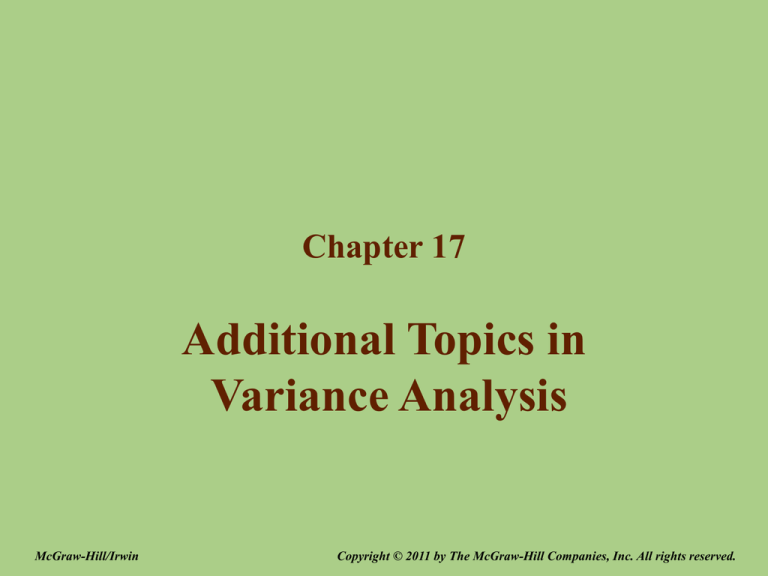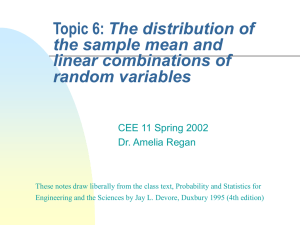
Chapter 17
Additional Topics in
Variance Analysis
McGraw-Hill/Irwin
Copyright © 2011 by The McGraw-Hill Companies, Inc. All rights reserved.
Profit Variance Analysis
L.O. 1 Explain how to prorate variances to
inventories and cost of goods sold.
• Most companies close variances to Cost of Goods Sold.
• Other companies prorate the variances.
17 - 2
LO1
Profit Variance Analysis
Bayou Division
Profit Variance Analysis (when units produced do not equal units sold)
Actual
Sales (units)
Sales revenue
Less: Variable costs
Variable manufacturing costs
Variable selling and administrative
Contribution margin
Fixed costs:
Fixed manufacturing overhead
Fixed selling and administrative costs
Profit
Mfg.
Variances
(based on
Marketing
90,000 units and Admin.
produced)
Variances
80,000
$840,000
332,890
68,000
$439,110
$28,890 U
195,500
132,320
$111,290
4,500 F
$28.890 U
$24,390 U
$ 4,000 F
$ 4,000 F
7,680 F
$11,680 F
Sales
Price
Variance
Flexible
Budget
Sales
Activity
Variance
Master
Budget
$40,000 F
80,000
$800,000
$200,000 U
100,000
$1,000,000
$40,000 F
304,000
72,000
$424,000
76,000 F
18,000 F
$106,000 U
380,000
90,000
$ 530,000
$40,000 F
200,000
140,000
$ 84,000
-0-0$106,000 U
200,000
140,000
$ 190,000
Total variance from flexible
budget = $27,290 F
Total variance from master budget = $78,710 U
17 - 3
LO1
Manufacturing Variances Based on
90,000 Units Produced
• Variable manufacturing costs:
Actual quantity produced (AP –SP)
• 90,000 × ($4.121 - $3.800) = $28,890 U
• Fixed manufacturing costs = $4,500 F
17 - 4
LO1
Closing Production
Cost Variance to COGS
• Journal entry to close production
variance to cost of goods sold:
Cost of Goods Sold
24,390
Fixed Overhead Price Variance
4,500
Variable Production Cost Variance
28,890
To close production cost variances to Cost of Goods Sold.
17 - 5
LO1
Prorating Production
Cost Variances
• Journal entry to prorate production variance to
cost of goods sold and finished goods inventory:
Cost of Goods Sold
21,680
Fixed Overhead Price Variance
4,500
Finished Goods Inventory
2,710
Variable Production Cost Variance
28,890
To close production cost variances to Finished Goods and
Cost of Goods Sold.
$21,680 (8/9 of the variance) is closed to Cost of Goods
Sold and $2,710 (1/9 of the variance) is closed to Finished
Goods Inventory.
17 - 6
LO1
Reconciling Variable Costing and
Absorption Costing
• Using variable costing, the entire fixed
production cost of $195,500 is expensed.
• Using standard full absorption costing, a portion
of the fixed overhead remains with
the 10,000 units in inventory.
10,000 × $2.00 = $20,000
$195,500 – $20,000 = $175,500
17 - 7
LO1
Standard Costs for Materials
Standard costs:
4 pounds per frame @ $.055 per pound = $2.20 per frame
Frames produced in August
80,000
Actual materials purchased and used:
328,000 pounds @ $0.60 per pound
= $196,800
• In addition, assume instead that 350,000 pounds
were purchased in August at $0.60 per pound
and 328,000 pounds were used.
• What are the variances?
17 - 8
LO1
(1)
Direct Materials Variance:
No Materials Inventory
Actual
(2)
Actual Inputs at
Standard Prices
(3)
Flexible Production
Budget
Actual materials price
(AP = $0.60)
× Actual quantity
(AQ = 328,000 pounds)
of direct materials
Standard materials price
(SP = $0.55)
× Actual quantity
(AQ = 328,000 pounds)
of direct materials
Standard materials price
(SP = $0.55)
× Standard quantity
(SQ = 320,000 pounds)
of direct materials
allowed for actual output
AP × AQ = $196,800
SP × AQ = $180,400
SP × SQ = $176,000
Price variance
$196,800 – $180,400
= $16,400 U
Efficiency variance
$180,400 – $176,000
= $4,400 U
Total variance
= $16,400 + $4,400 = $20,800 U
17 - 9
LO1
(1)
Direct Materials Variance:
Materials Inventory
Actual
(2)
Actual Inputs at
Standard Prices
(3)
Flexible Production
Budget
Actual materials price
(AP = $0.60)
× Actual quantity
(AQ = 350,000 pounds)
of direct materials
Standard materials price
(SP = $0.55)
× Actual quantity
(AQ = 350,000 pounds)
of direct materials
AP × AQ = $210,000
SP × AQ = $192,500
Standard materials price
(SP = $0.55)
× Standard quantity
(SQ = 320,000 pounds)
of direct materials
allowed for actual output
Purchase
Computations
Usage
Computations
Price variance:
$210,000– $192,500
= $17,500 U
$0.55 × 328,000
pounds used = $180,400
SP × SQ
$0.55 × 320,000
pounds allowed = $176,000
Efficiency variance:
$180,400 – $176,000 = $4,400 U
17 - 10
LO1
Materials: Standard Costing System
• Journal entry to record purchase of materials:
Materials Inventory
192,500
Material Price Variance
17,500
Accounts Payable
$210,000
To record the purchase of 350,000 pounds of material with an actual
price of $0.60 per pound and a standard price of $0.55 per pound.
• Journal entry to record materials used:
Work-in-Process Inventory
176,000
Material Efficiency Variance
4,800
Materials Inventory
$180,400
To record the use of 328,000 pounds of material with a standard price
of $0.55 per pound. Standard use is 320,000 pounds.
17 - 11
Market Share Variance and
Industry Volume Variance
L.O. 2 Use market share variances to
evaluate marketing performance.
• Industry volume variance:
Portion of the sales activity variance due to
changes in industry volume
• Market share variance:
Portion of the activity variance due to changes
in the company’s proportion of sales in the
markets in which the company operates
17 - 12
Sales Activity Variances
L.O. 3 Use sales mix and quantity variances
to evaluate marketing performance.
• Sales mix variance:
Variance arising from the relative proportion of
different products sold
• Sales quantity variance:
Variance occurring in multiproduct companies from
the change in volume of sales, independent of any
change in sales mix
17 - 13
Production Mix and Yield Variances
L.O. 4 Evaluate production performance using
production mix and yield variances.
• Product mix variance:
Variance that arises from a change in the relative
proportion of inputs (a materials or labor mix variance)
• Production yield variance:
Difference between expected output from a given level
of inputs and the actual output obtained from those inputs
17 - 14
Variance Analysis in
Nonmanufacturing Settings
L.O. 5 Apply the variance analysis model to nonmanufacturing costs.
Output Measures in Service Organizations
Organization
Public accounting, legal, and consulting firms
Hotel
Airline
Hospital
Professional staff hours
Room-nights, guests
Seat-miles, revenue-miles
Patient-days
17 - 15
Variance and Standards
L.O. 6 Determine which variances to investigate.
• Management by exception:
Approach to management requiring that reports
emphasize the deviation from an accepted base
point, such as a standard, a budget, an industry
average, or a prior period experience.
17 - 16
End of Chapter 17
McGraw-Hill/Irwin
Copyright © 2011 by The McGraw-Hill Companies, Inc. All rights reserved.







